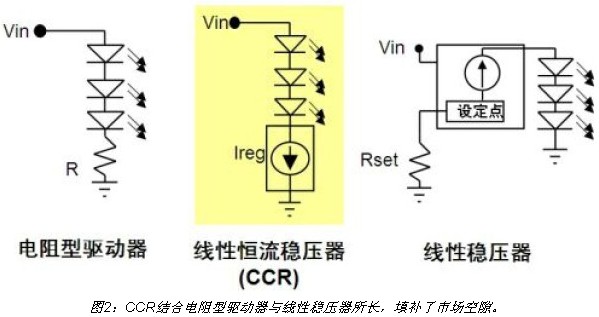With its advantages of energy saving, long service life and rich color combination, LED lighting has become one of the fastest growing semiconductor fields. In recent years, its compound annual growth rate (CAGR) is as high as 20%. It is estimated that the global LED market will be in 2012. The value will reach $11.4 billion, and the prospects are very impressive. The fastest growing and most demanding applications will be low current LED lighting applications.
There are two types of typical LED drivers on the market today, namely linear drivers and switch drivers; there are three further subdivisions, namely switching regulators, linear regulators and resistive drivers. These three drivers are suitable for different levels of current applications, see Figure 1. Switching regulators are used in high current applications with currents greater than 500 mA because linear drivers are limited to their own structure and cannot provide such large currents. In low current applications with currents below 200 mA, linear regulators are often used. Resistive drivers; in medium current applications from 200 to 500 mA, either linear regulators or switching regulators are available.

Switching regulators are energy efficient and offer excellent brightness control. The linear regulator structure is simple, easy to design, provides constant current and overcurrent protection, has an external current set point, and has no electromagnetic compatibility (EMC) issues. Resistive drivers use a simple discrete device such as a resistor to limit the LED string current. This is an economical LED driver solution that is equally easy to design and has no EMC issues.
As the world's leading supplier of high performance, energy efficient silicon solutions, ON Semiconductor offers a wide selection of switching regulators and linear regulators for different LED applications. At the same time, customers on the market also need a driver that is more economical than switching regulators and common linear regulators, but much more powerful than resistive drivers. Under this circumstance, ON Semiconductor has adopted a patent-pending self-biasing transistor (SBT) technology, combined with its own superior process control capabilities, to introduce a new LED driver solution - discrete linear constant current regulator (CCR) fills this market gap and further enriches ON Semiconductor's broad lineup of LED driver products.
Low current LED application and driver comparison
The new linear constant current regulators are suitable for low current LED applications from 20 mA to 200 mA. As in automotive applications, the current requirements for combined taillights are typically only tens of milliamps (mA). In addition, in commercial and industrial applications such as billboard text circuits and backlit display cards, the input voltage is typically as high as 30 Vdc and the LED current is between 20 mA and 150 mA. In buildings such as decorative lighting, work lights, landscape lighting, counter lighting, and general lighting applications, the input voltage is typically 12 to 48 Vac or 120/220 Vac, and the LED current is only between 20 and 100 mA. In addition, LEDs for household appliances such as refrigerators and washing machines use LEDs for small LCD backlights or alternative lighting bulbs. These applications also require low-current LED drivers.
In low-current LED applications, the resistive driver, despite its low cost and simple structure, has a low forward current at low voltages, which can result in insufficient LED brightness and transient conditions such as load dump. The LED may be damaged. Moreover, this solution requires proper LED coding, large resistance inventory, and low energy efficiency.
Compared to resistive drivers, linear constant current regulators provide regulated current, provide constant brightness over a wide voltage range, protect LEDs from overdrive at high input voltages, and provide higher output at low input voltages. brightness. Thanks to its constant current characteristics, customers can reduce or eliminate the coding costs of different LEDs from different suppliers, resulting in lower total system cost.
